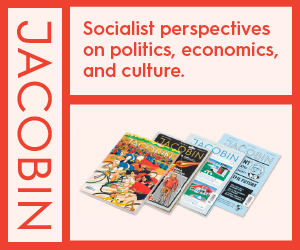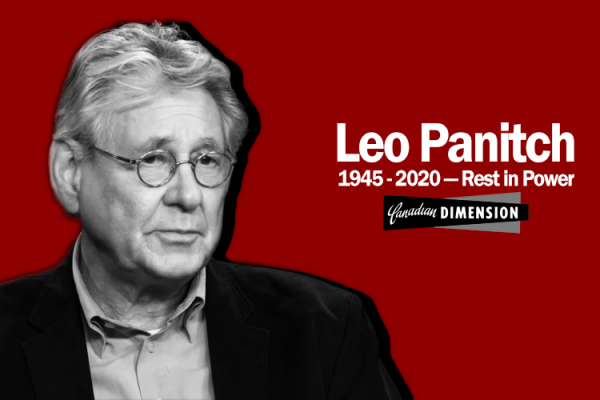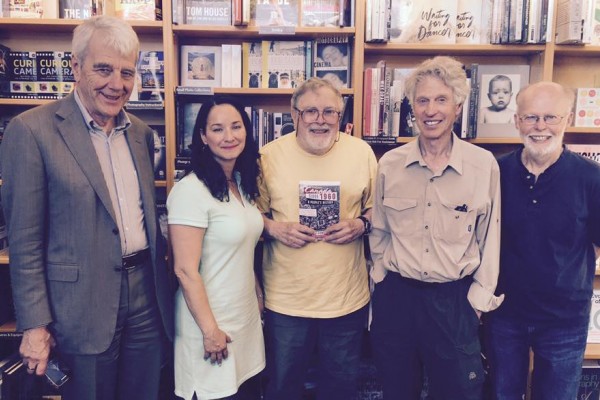Red Flags: Reflections on racism and radicalism

Strikers face down the North West Mounted Police. Illustration by David Lester, from the Graphic History Collective’s 1919: A Graphic History of the Winnipeg General Strike, published by Between the Lines, 2019.
In light of contemporary commemoration debates, we seem to be scrutinizing and selecting and reselecting our ancestors very openly these days, which can only be a good thing. Without the right ancestors we’ll never have the right stuff to remake the world, and we’ve been robbed of so many good ones. Maybe that’s why a lot of us are shy about speaking frankly about our predecessors’ shortcomings – we’re afraid we won’t have anyone left to look up to. Can we, then, celebrate the wonderous achievement that was the Winnipeg General Strike – an achievement that belongs not only to Canadians but to all the working people of the world – and be honest about its weaknesses at the same time? If we had moved past those weaknesses, it wouldn’t matter, but we haven’t. Racism on the left, for one, is still a big, glaring problem in 2019. As people who celebrate the Winnipeg General Strike, that simple reality compels us to reflect on the strike’s racist tendencies, to think about how we’ve inherited them and what has become of them. To be clear, what I am talking about is a tendency during the strike, that is both more and less than individual attitudes, that supported racist structures, and that drew all kinds of boundaries within the working class. It survives in a new form today, and it divides us and makes us weak.
Capitalism lives and breathes racism. It can’t survive without it. It picks it up, cultivates it, and injects it into everything. The people who call the shots encourage white supremacy among those who don’t. Because of this, the particular racial strategies of Winnipeg capitalists in 1919 are crucial for understanding the racism of our striking ancestors. In turn, this requires that we comprehend that those businessmen were the products of a specific racist tradition, namely the process of colonial conquest that reached its most violent depths in the North-West just three decades before the strike. Only 34 years separate the battle at Batoche from the revolt in Winnipeg, yet the historiographic failure to discuss them together implies the two belong to fundamentally separate stories. This is a problematic trend that perpetuates erasure and falsely records a time of death for Indigenous political life in Canada somewhere around 1885.
Urban industry as colonial legacy
To correct this mistake, we have to acknowledge that the Canadian occupation of the North-West and the later development of urban industry were designed by the same people for the same purpose. Industrial cities were created to preserve the obscene wealth and power seized through the region’s settler-colonial transition and required similarly massive levels of human sacrifice and produced similarly fierce resistance. As Winnipeg’s titans of industry turned primarily from stealing land to stealing labour, they inevitably brought specific ways of thinking, feeling, planning, and acting – forged in their attempted conquest of Indigenous peoples – to their attempted exploitation of industrial workers. When Winnipeg workers struck, bosses made use of settler-colonial legacies to preserve urban industrial accumulation. This was more than a coincidence and more, even, than a tradition inherited from their fathers.
Many of the key figures involved in suppressing the Winnipeg General Strike had themselves participated, as young men, in campaigns of colonial violence against the Métis and First Nations communities in the North-West in the late nineteenth century.
Examples include A.J. Andrews, leading lawyer and spokesman of the strikebreakers’ or Citzens’ Committee of One Thousand, and a former Winnipeg mayor who fought at the age of 20 under lieutenantcolonel Thomas Scott during the 1885 North-West Resistance; D.J. Dyson, a prominent Committee of One Thousand member, pickle manufacturer, and former mayor of Winnipeg, who travelled west of Ontario for the first time at the age of 21 to fight alongside Andrews at Batoche; General Huntley Ketchen, leader of the eventual Canadian military offensive against the strikers in Winnipeg, who was born in India to a British Imperial Army major, joined the Imperial Army himself at the age of 18, came to Winnipeg at 22 to serve in the North-West Mounted Police (NWMP), and later served as a lieutenant in the Boer War; Hugh F. Osler, a real estate, oil, and shipping capitalist and director of Great-West Life Assurance, whose uncle Britton Osler prosecuted Louis Riel in 1885; and factory owner E.F. Hutchings, known to glorify “Indian graves” as a symbol of regional progress, and a prominent member of Winnipeg’s business elite during the strike. These biographical details broaden our view of the imperial context in which the great early twentieth-century businessmen were raised and of the settler-colonial society in which they vigorously participated. These details also allow us to see their response to militant workers as being a part of a regional tradition of violent repression.
Racist rhetoric of the bosses
A racial and national sense of belonging – a belief in the righteous mixing of Anglo-Saxon blood and Turtle Island soil to create a British settler colony – was no less instrumental for the stealing of labour than for the stealing of land in the North-West. Winnipeg’s businessmen deployed this particular alchemic fantasy to dehumanize those who stood in the way of their industrial accumulation strategy and used it to avoid respectful negotiation aimed at a more equitable distribution of regional power, just as they had done in their relations with Indigenous peoples in the late-1800s. As soon as the Winnipeg General Strike began, the Committee of One Thousand published ads in the Free Press, Tribune, and Telegram casting strikers as part of a subhuman race – bearers of an inferior brand of European civilization – and urging the federal government to deport them. They began to wear Union Jacks on their coats as an antistrike symbol and marched in the streets under the banner “TO HELL WITH THE ALIEN ENEMY.” Labour agitation, revolutionary spirit, and any number of radical political and economic ideas were marked as racially “other” – intrinsically unreasonable and beyond the pale of white British-Canadian society. “I.W.W. [Industrial Workers of the World] IDEALS DON’T APPEAL TO WHITE MEN,” read the cover of the 21 May 1919 Winnipeg Citizen, the Committee of One Thousand’s special anti-strike newspaper. The city’s “ironmasters” publicly lamented the overtaking of “responsible” Anglo-Saxon labour leaders by “unskilled workmen of alien origin, permeated with … socialistic and anarchistic theories.”
This kind of white supremacist rhetoric was rolled out in support of a policy that combined non-negotiation with physical force. Business-backed vigilantes – “The Specials” – patrolled the city armed with baseball bats, pipes, and chains, “brutally attacking any person who voice[d] any opinion favourable to the strikers.” Bloody Saturday took this stance to its logical conclusion, when Canadian military troops, RNWMP officers, and The Specials armed with machine guns – Canada’s weapon of choice at Batoche as well – descended on strikers and opened fire. The striker killed in the attack, Mike Sokolowski, was described as a “foreigner” by General Ketchen in his report. Strikers were then arrested en masse, labour temples and offices were raided, and the city was put under military occupation, effectively ending the strike. Labour leaders were taken from their homes in the middle of the night, imprisoned in Stony Mountain federal penitentiary, and threatened with deportation. These were the conditions in which Winnipeg strikers negotiated their relationship to racialism.
The strike is sometimes mythologized as a struggle between white Anglo-Saxon Protestant (WASP) bosses flying the Union Jack and Slavic workers aspiring to the hammer and sickle. It can be heartening to imagine our ancestors as turning their backs on the bosses’ Canadian patriotism, but this way of remembering the strike is a regurgitation of the Committee of One Thousand’s propaganda. In fact, many strikers took pains to play into the bosses’ racist and nationalist narrative of the strike, striving to dispel the idea that they were anything but loyal, white, empire-loving British subjects. For this purpose, it helped that virtually all members of the Strike Committee were white Anglo-Saxon Protestant men who followed the same path west from Britain and Ontario, during the previous three decades, as did virtually all the Winnipeg capitalists. With their roots in the factory cities of northern England and Scotland, strike leaders tended to craft their political vision within the parameters of the dominant settler-colonial framework that aspired to make Canada a “Better Britain.” Strikers regularly placed the Union Jack at the front of marches, while the phrase “BRITONS NEVER SHALL BE SLAVES” became a popular rallying cry in the strikers’ fight for collective bargaining rights. In Ottawa, the prostrike Member of Parliament for Winnipeg Centre declared that the Winnipeg “strikers are as loyal citizens as Canada [has] ever had.”
While the strategy of presenting the strike as a WASP movement did not make much room for it, the necessity of anti-racist alliances was certainly noted – and even celebrated – by some strikers. “For the workers of Winnipeg, the barriers of colour, race and creed had been torn down and are now beyond hope of being rebuilt,” said one striking worker, “Which is as it should be.” Many workers also saw through the capitalists’ strategic xenophobia. “The bosses have no quarrel with the rich alien, no quarrel with the unorganized alien,” one worker pointed out, while an assembly of strikers at the time asserted, “this body of workers recognize no alien but the capitalist.”
At other times, however, Winnipeg strikers reiterated the businessmen’s racist mythology.
Winnipeg mural by
Tom Andrich, 2006.
The mural was ripped
from the wall and
damaged in a severe
storm in Sepember,
2012 (The Murals of
Winnipeg).
Strikers perpetuate racist rhetoric
Strike actions and publications were tarnished by anti-immigrant and anti-Black rhetoric. Strike parade banners called for Canada to “DEPORT ALL UNDERSIRABLES.” “[W]e are opposed to any wholesale immigration of workers from various parts of the world,” one group of strikers wrote at the time of the strike, and especially those “who would be brought here at the request of the ruling class.”
When Winnipeg City Council asked city workers to sign a pledge promising not to unionize, strike leaders responded: “ONLY A SLAVE COULD SIGN IT. A FREE MAN, A WHITE MAN – NEVER!” In the aftermath of Bloody Saturday, strikers expressed outrage by asking in the Western Labor News – in reference to recent events in England, in which participants in “negro” uprisings had been protected from deportation – “Have Scotchmen, Englishmen, and Canadians in Canada less rights than negroes in England?”
Anti-Black racism within the Winnipeg General Strike occurred during a time of highly visible organizing of Black labour in Canada. The Universal Negro Improvement Association (UNIA), in particular, had an active Canadian membership among both domestic and factory workers in the 1910s. In Winnipeg especially, Black train porters were extremely well organized. Neither was it unheard of elsewhere on Turtle Island for mostly white industrial workers’ organizations – such as the Communist Party USA – to collectively align themselves with Black workers in these years. Thus, the racism of Winnipeg’s WASP and Slavic workers cannot be written off as a “product of the times.” To do so would be to erase the labour organizing of people of colour and the antiracist consciousness of many white workers at the time, and to risk downplaying the reality that people also shape their times.
It is noteworthy too, that revolutionary workers in Winnipeg apparently remained silent while Indigenous peoples were also sacrificed for the urban industrial agenda. Strikers in 1919, for instance, failed to pursue a relationship of solidarity with the Anishinaabe people of Shoal Lake, whose lands, as historian Adele Perry has shown, were being stolen and deformed without their consent for the construction of the Winnipeg aqueduct – a key infrastructural requirement for Winnipeg’s industrial economy – at the very same time as the Winnipeg General Strike. Strikers were keenly interested in the aqueduct – they organized educational tours that presented it as a marvel of modern progress and engineering – but showed little interest in the people at the other end of the pipe. In a time and place of such intense solidarity and opposition to industrial capitalism’s disregard for human life, the lack of solidarity shown to people of Shoal Lake by Winnipeg workers is remarkable and reveals just how successfully anti-Native racism divided and conquered.
Missed opportunity should fuel change
The important point is that the Canadian development of the North-West produced two powerful negations of capitalism within the same country – Indigenous peoples and migrant workers – yet the barriers of racism and the lure of white supremacy prevented them from joining forces. Rather than making common cause with all other peoples dispossessed and exploited by Canadian industrialists, too many migrant workers in Winnipeg were successfully encouraged to formulate their right to freedom in terms of the rights of white people, either implicitly or explicitly.
These workers failed to transcend the racial terms of belonging imposed on the North-West by Canadian occupation, which granted a modicum of political and economic freedom to “industrious and peaceable” white men. Winnipeg’s ironworkers, carpenters, and cleaners, in other words, too often sought their freedom through the racist channels they knew white farm workers had used to obtain it a generation earlier. Whereas Indigenous peoples’ political consciousness drew on their own autonomous cultures and traditions, the consciousness of European-descended workers was imbued with the values and habits of the Europeandescended ruling class, including its strong tendency toward racial thinking. This prevented workers of European descent from taking the opportunity to draw on powerful, prior regional radical traditions established by the Anishinaabe and the Métis and from seeing Indigenous people as likely allies in struggle. Strikers’ minds, clouded by colonial ideology, adhered to a myth of the supposed end of Indigenous life and politics in the North-West. Whenever they refused subordination specifically on the basis of being “Britons,” “Scotchmen,” “Englishmen,” “Canadians,” and “white men”; remained silent and kept their distance from the matter of industrial capitalism’s predations on Indigenous peoples; fomented anti-Black racism; or performed loyalty to British and Canadian colonizers, Winnipeg’s industrial workers missed a tremendous historical opportunity to oppose the white supremacist and settler-colonial underpinnings of capitalism in the region.
One hundred years and many more failures later, these dynamics reverberate. Labour-aligned parties preside over – and celebrate – the expansion of Canada’s most gruesomely racist structures: from the child-theft apparatus to policing and imprisonment to oil pipelines and hydroelectricity extraction. In Manitoba, organized labour has its fingerprints all over a regional culture of human sacrifice that flows from these structures and fuels racism, arrogance, and distrust among working people. The fact that labour has so thirstily expanded the police forces and prisons that were used against the Winnipeg General Strike is a reality worth reflecting on and actively organizing to change.
Owen Toews is the author of Stolen City: Racial Capitalism and the Making of Winnipeg (2018).
This article appeared in the Summer 2019 issue of Canadian Dimension (CD Goes Digital).










